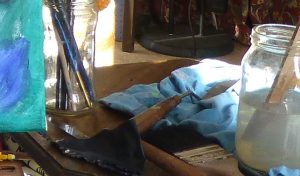Advice for Safe Disposal of Painter’s Rinse Water
Why Acrylics should not be washed down the drain
As an alternative to oils Acrylic paints are a good choice because of the speed of drying and the lack of fumes, and being water based it is easy to clean up.
Even so, care must be taken when disposing of excess paint and rinse water. It is not a good idea to pour solutions of paint down the drain, and that includes street drains and the garden.
Acrylic polymers are a kind of plastic and it has been discovered that even tiny particles in water systems end up in the waterways and eventually are carried to the sea. Many professional pigments are toxic and even the ‘nontoxic’ makes, such as our own Outlines paints, can still be a problem for waste-water treatment processes.
Dried acrylic paint is non toxic and is inert in landfill. As with all plastics, acrylic paints may be harmful if allowed to go into water systems, rivers and seas.
Disposal As Solid Waste
The solution is to allow all the paint excess to dry. When dry, the paint is stable just as it is on the painting. Any toxic chemicals can only be absorbed when diluted so this works for all acrylic paints.
Some like to uses brushes to paint and others like pallet knives or even their fingers, but whatever the tools you prefer, it’s a good practice to wipe off the excess as much as possible before rinsing them.
This will significantly reduce the amount of paint in the rinse water. You can use paper towels, newspaper or rags. I like to keep old T shirts cut into small pieces to use as rags. I find I can keep on using them when they are dried until all the material is coated.
At the end of a session the rinse water can be set aside to settle or for Dehydration.
Read more Tips and Articles about Acrylic Paints or read on for more information about dehydration.
Problem of slow evaporation
Rinse water from acrylic paint tends to dry much more slowly than regular water. The thin scum on the water surface probably inhibits evaporation. We must find ways to help the water evaporate faster.
 Ways to dehydrate rinse water
Ways to dehydrate rinse water
The simplest solution is to leave the rinsing jar alone for a while to allow the contents to settle. You may be able to pour off some water then stuff the jar with newspaper which will absorb the water allowing it to be thrown in the household rubbish bin. But you might not have a big enough supply of paper handy, especially if you have been painting with a group of people.
In this case you might keep a selection of containers that allow the water to evaporate. In winter when there is heating a metal pot can be left near a radiator or other heat source whereas in the summer a wider, shallow plastic container may be suitable. I like to cover mine with a fine mesh to keep any wildlife from getting in. Breezes will help with evaporation and a spot near an open window will do for those who have no garden.
The larger container need not be cleaned out every time but can be refilled and dried until the layers of dried or moist residue can be scraped out.
Humid atmosphere problems
If you live in a humid environment you may find the water will not evaporate. Then you may have to resort to a chemical method to solidify the particles so that they can be filtered.
Golden™ is a leading manufacturer of acrylic paint and mediums and they have a page describing the dehydration process here.
This is their list of the equipment you will need. Their article shows you how to deal with large quantities, you may need to adjust to suit your situation. Where possible, I will add links to places where they can bought.
Supplies Needed to Process Rinse Water
- Paper coffee filters. Large industrial filters can be found at ‘Cash and Carry’ restaurant suppliers.
- Plastic funnel. Size to match the filters and bucket being used.
- 2 Plastic buckets. Choose a suitable size.
- Stirring Paddle. You can buy one or use a flat piece of wood.
- Aluminium Sulphate and Hydrated Lime. Commonly available at Garden centres.
- Weighing device or Measuring spoons. A supermarket that sells kitchen stuff.
- pH Paper – available from a laboratory supplies business.
Other Ways of Filtering or Separating Paint from Water
There are others who recommend using sand to filter the water, but I have not tried the method.
For those who use best quality artist watercolours, the same principles apply to colours containing toxic pigments. This article should help you to practice responsible disposal methods for acrylic rinse water.
Further Reading:
Environmentally Friendly Practices for Artists from the Agora Gallery
In the USA the Local services Department in King County, Washington has a whole section on Art Hazards
*Links to external sites will open in a new tab or window. Outlines is not responsible for the accuracy of information found.
Click Here: For more Articles to Inspire and Learn about Acrylic Paints
